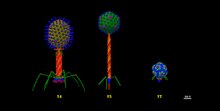| Caudoviricetes | |
|---|---|
 | |
| Structures of T Bacteriophages representing the seven T types of Escherichia coli phages described by Max Delbruck in the 1940s. T4 of the Myoviridae family, T5 of the Siphoviridae family, and T7 of the Podoviridae family. The structures were built from individual protein data bank (pdb) files in the UCSF Chimera software, which were updated to the year 2024 and at real scale. | |
| Virus classification | |
| (unranked): | Virus |
| Realm: | Duplodnaviria |
| Kingdom: | Heunggongvirae |
| Phylum: | Uroviricota |
| Class: | Caudoviricetes |
| Subdivisions | |



Caudoviricetes is a class of viruses known as tailed viruses and head-tail viruses (cauda is Latin for "tail"). [1] Under the Baltimore classification scheme, the Caudoviricetes are group I viruses as they have double stranded DNA (dsDNA) genomes, which can be anywhere from 18,000 base pairs to 500,000 base pairs in length. [2] The virus particles have a distinct shape; each virion has an icosahedral head that contains the viral genome, and is attached to a flexible tail by a connector protein. [2] The order encompasses a wide range of viruses, many containing genes of similar nucleotide sequence and function. However, some tailed bacteriophage genomes can vary quite significantly in nucleotide sequence, even among the same genus. Due to their characteristic structure and possession of potentially homologous genes, it is believed these viruses possess a common origin. [2]